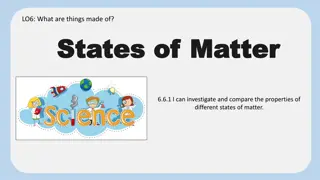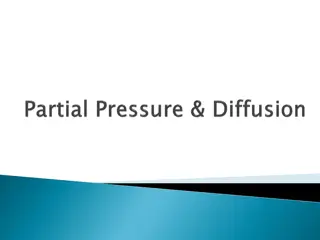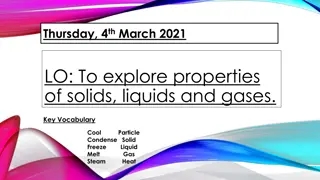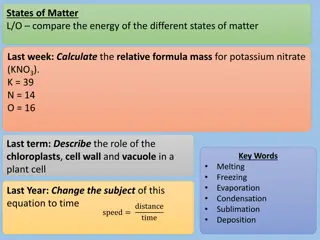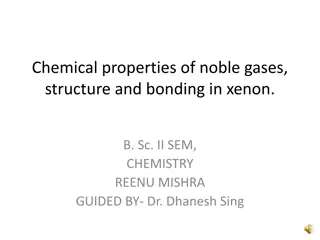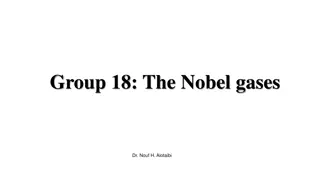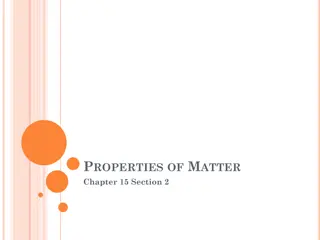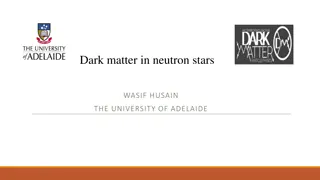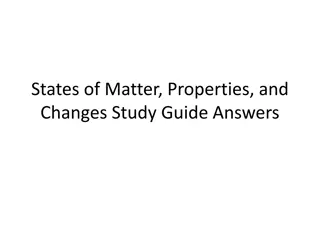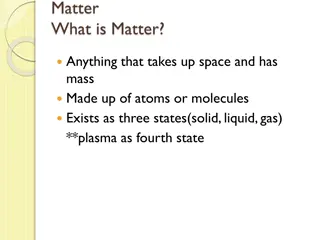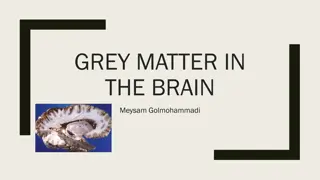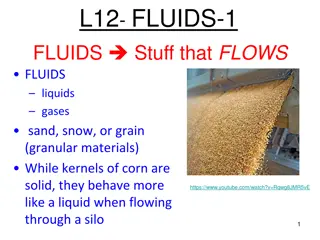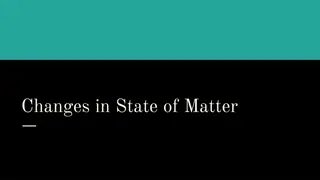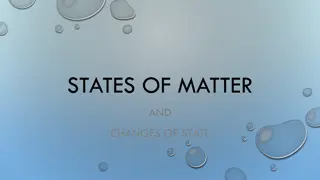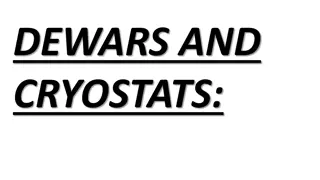States of Matter and Properties of Gases
Matter can be classified into gas, liquid, and solid based on particle arrangement, shape, and motion. Gases in pharmacy are crucial for various applications like anesthesia and aerosols. Properties of gases include compressibility, pressure exertion, diffusion, and expansion. Gas laws such as Boyle's, Charles's, Amonton's, and Avogadro's laws help explain gas behavior under different conditions.
Download Presentation

Please find below an Image/Link to download the presentation.
The content on the website is provided AS IS for your information and personal use only. It may not be sold, licensed, or shared on other websites without obtaining consent from the author.If you encounter any issues during the download, it is possible that the publisher has removed the file from their server.
You are allowed to download the files provided on this website for personal or commercial use, subject to the condition that they are used lawfully. All files are the property of their respective owners.
The content on the website is provided AS IS for your information and personal use only. It may not be sold, licensed, or shared on other websites without obtaining consent from the author.
E N D
Presentation Transcript
Matter can be classified according to its state into: 1. Gas 2. Liquid 3. Solid Character Solid Liquid Gas Particles arrangement Particles close together in a regular arrangement Closely packed together in an irregular arrangement Arrangedtotally irregular Have fixed shape and volume Have no fixed shape but fixed volume Have no fixed shape and volume Shape Motion of particles No freely motion but vibrate in its positions Move around past each other Move randomly Ability to compress No compression Little Easy
Gases and volatile substances are encountered in pharmacy mainly as anaesthetic gases, volatile drugs and aerosol propellants. This part deals with the properties of gases and vapours, including the way in which the vapourpressure above solutions varies with the composition of the solution and the temperature. The factors governing the solubility of gases in liquids are reviewed and related to the solubility of anaesthetic gases in the complex solvent systems comprising blood and tissues.
Properties of gases Gases can be compressed into smaller volume Gases exert pressure on their surroundings and always form homogenous mixture with other gases Temperature affect either the volume or the pressure or both. Gas diffuse (move throughout any available space). Gases expand without limits. Gases measured in : pressure, volume, temperature and number of mole. 1. 2. 3. 4. 5. 6.
Boyle`s law Charles`s law Amonton`slaw Avogadro`s law General gas law
At constant temperature, the volume of a definite mass of a gas is inversely proportional to the pressure. This means that the product of the pressure and volume of a given mass is constant at constant temperature. PV = K (at constant n and T) Where; P is the pressure, V is the volume and K is a constant that depends on the number of mole of the gas and the temperature. If a definite mass of gas has a volume =V1and pressure = P1and either the volume or pressure is changed to V2or P2at constant temperature then P1V1= P2V2
A sample of oxygen occupies 10 L under a pressure of 790 torr (105 kPa). At what pressure would it occupy 13.4 L if the temperature did not change? Solution: P1= 790 torr, V1= 10 L, and V2= 13.4 L, P2= ? P1V1= P2V2 790 x 10 = P2x 13.4 P2= 7900 / 13.4 P2= 590 torr
At constant pressure, the volume occupied by a definite mass of a gas is directly proportional to its absolute temperature. Mathematically, Charles`s law can be written as follow: V = KT (at constant n and P) Where; P is the pressure, V is the volume and K is a constant that depends on the number of mole of the gas and the pressure. If a definite mass of gas has a volume =V1and temperature= T1and the volume is changed to V2at constant pressure then V1/T1= V2/T2 or V2/ V1=T1/ T2 The equation is valid only when the temperature in Kelvin (K = C + 273), However, volume can be expressed in any volume unites such as; Liters, milliliters or cubic feet
A sample of nitrogen occupies 117 mLat 100 C . At what temperature in C, would it occupy 234 mLif the pressure did not change? Solution: T1= 100 C, V1= 117 mL, and V2= 234 mL, T2= ? T1= 100 C = 100 + 273 = 373 K V1/T1= V2/T2 T2=V2 x T1/ V1 T = 234 x 273 / 117 T2= 746 K T2= 746 -273 = 473 C
Combination of Boyle`s law and Charles's law in a single expression gives the combined gas law. Boyle` law P1V1= P2V2 Charles`s law V1/T1= V2/T2 P T P V V = Combined gas law for constant amount of gas 1 1 2 T 2 1 2 When any five of these variables are known, the sixth variable can be calculated. Units: Volume can be expressed in any units, pressure also can be expressed in any units, but temperature must be in Kelvin (absolute temperature).
The pressure and temperature can affect the volume (and therefore the density) of a gas. It is convenient to choose some standard temperature and pressure as a reference points. By international agreement, the standard temperature is exactly 0 C and the pressure is one atmosphere (=760 torr) or (760 mm Hg).
A sample of neon occupies 105 L at 27 C under pressure of 985 torr. What volume it occupy at standard temperature and pressure (STP). V1= 105 L , T1= 27 C = 27 + 273 = 300 K, P1= 985 torr STP means , P2= 760 torr and T2= 0 C = 0 + 273 = 273 K V P T 300 x x V 760 300 1. 985 105 x 760 xV P V = = 2 1 1 2 T 2 273 1 2 985 105 273 = = 124 L 2 x A volume of a gas occupies 12 L at 240 C under a pressure of 80 kPa. At what temperature would the gas occupy 15 L if the pressure was increased to 107 kPa? 1. (answer T = 858 K or 585 C)
At constant pressure and temperature, equal volumes of all gases contain the same number of molecules. Or At constant pressure and temperature, the volume (v1) occupied by gas sample is directly proportional to the number of mole (n1) of gas. V n or V = k n or V/n = k at constant P and T For of two samples of gases at the same temperature and pressure, the relationship between volumes and number of moles can expressed as follow: n n V= V 1 2 at constant P and T 1 2 Standard molar volume: is the volume occupied by a mole of gas at standard temperature and pressure (STP). Standard molar volume of ideal gas is 22.414 liters per mole
According to the previous equations, gas can be described in terms of its pressure, temperature, volume and number of mole. If any three of these variables are known, the fourth could be calculated. Ideal gas is one that obeys exactly these gas laws. Many real gases show slight deviations from ideality, but at normal temperature and pressure the deviations are usually enough to be ignored. - Boyle`s law V 1/p - Charles`s law V T -Avogadro`s law V n Ideal gas equation or ideal gas law: (no restriction) or P at constant T and n at constant P and n at constant P and T nT nT PV = nRT V V = (P ) R
PV = nRT The constant R is called the universal gas constant and its value is dependent of the unites of P, V and T. The numerical value of R can be calculated as follow: If one mole of an ideal gas occupies 22.414 liters at 1.000 atmosphere and 273.15 K (STP) . PV =nRT R = PV/nT R = (1 x 22.414 ) / 1 x 273.15 =0.082057 L atm / mol K Usually the universal gas constant is equal to 0.0821 8.314 x 10-3L Pa/ mol K 8.314 x 10-3g m2/S2mol K 8.314 J/K mol L atm / mol K
Example 1: What pressure in atm, is exerted by 54.0 g of Xe gas in 1.0 L flask at 20 C. (atomic number = 54 and atomic mass= 131.3 for Xe). Solution V= 1.0 L, T= 20 + 273 = 293 K Number of mole (n) = grams / (M.Wt x V in L) = 54 / 131.3 = 0.411 mol . 0 411 0821 . 0 293 nRT x x = = = PV = nRT . 9 89 P atm 1 V Example 2: What is the volume of a gas balloon filled with 4.0 moles of He when the atmospheric pressure is 748 torr and the temperature is 30 C. P = 748 torr = 748/760 = 0.984 atm, n = 4.0 mol, T= 30+273 = 303 K nRT V = = 0 . 4 0821 . 0 303 x x = 101 L . 0 984 P
Example: A 0.109 g sample of a pure gaseous compound occupies 112 mLat 100 C and 750 torr. What is the molecular weight of the compound? Solution The number of moles is calculated using Ideal gas law V= 112 mL= 0.112 L, P = 750 torr = 750/760= 0.987 atm, T = 100 + 273 =373 K x RT 373 0821 . 0 . 0 987 . 0 122 PV = = = 00361 . 0 n mol x Number of mole (n) = weight (in gram) / M Wt. Weight Wt M . = ( ) . 0 109 gram = = 30 2 . mol 00361 . 0 moles
Ideal gas always obeys the gas law (PV=nRT). Real gas deviate (not obey) gas law (PV nRT) Gases tend to behave ideally at high temperature and low pressure. Real gases deviate from ideal gases when T is very low and P is very high. At high pressure, the distance between gas molecules are small, and intermolecular forces will developed between the molecules. Therefore, the less gas resemble ideal gas (Gases tend to liquefy at high pressure). At low temperature, the gas molecules move slowly and close to each other . So low temperature means low energy available to break intermolecular forces. Therefore, colder temperature, make gases act less ideally (Gases tend to liquefy at low temperature). Real gas deviate from the kinetic theory of gas in two points:- 1- Real gases posses attractive forces between molecules. 2- Every molecule in real gas has a real volume
The kinetic theory of gases assumes that the gas molecules behave as perfectly elastic spheres having negligible volume with no intermolecular attraction or repulsion. In some types of aerosol (compressed gas aerosols) an inert gas under pressure is used to expel the product as a solid stream, a mist or a foam. The pressure of gas in an aerosol container of this type is readily calculated using the gas laws, as in Example 2.1.
Most gases obey the ideal gas law to a good approximation when near room temperature and at a moderate pressure. At higher pressures one might need a better description. . The van derWaals equation of state is an P 2 + = V ( ) nb nRT 2 V The symbols a and b represent constant parameters that have different values for different gases. According to van derWaal equation, the pressure of a real gas will be lower than that of the ideal gas because attraction to neighboring molecules tend to decrease the impact of the gas molecules on the wall of the container .
The measured pressure of 1.000 mol of a gas of a volume of 1.000 L at a temperature of 503 K is 30 atm. A. Is the gas under these conditions behaves as an ideal gas or not ? B. Calculate the pressure of the gas using van der Waal equation ? (a= 17.0 L2atm/mol2and b = 0.136 L/mol) Answer Ideal gas law: PV = nRT or P=nRT/V =1 x 0.0821 x 503 /1 = 41.3 atm This value is higher than the measured value, so it do not obey the gas law. van der Waal equation V V x V nb V . 0 1 1 ( ) ( 2 an + = ( ) P nb nRT 2 2 2 1 0821 . 0 503 17 0 . ) 1 ( 2 nRT an x 136 x = = = 30 8 . P atm 2 ) ) 0 . 1 ( x The calculated value is close to that obtained by van der Waal equation
Liquids have definite volume because intermolecular forces of attraction between molecules is just strong enough to confine the molecules in a definite space. A liquid has no definite shape and acquires the shape of the container because the intermolecular forces is weaker than solid. All liquids have intermolecular forces called van derWaal forces in addition to other forces in certain solvents. A liquid is comprisable because the distance between the molecules is larger in liquids than in solid. Each liquid has the following properties: 1-Vapor pressure, 3-freezing point and 2-boiling point, 4-surface tension


